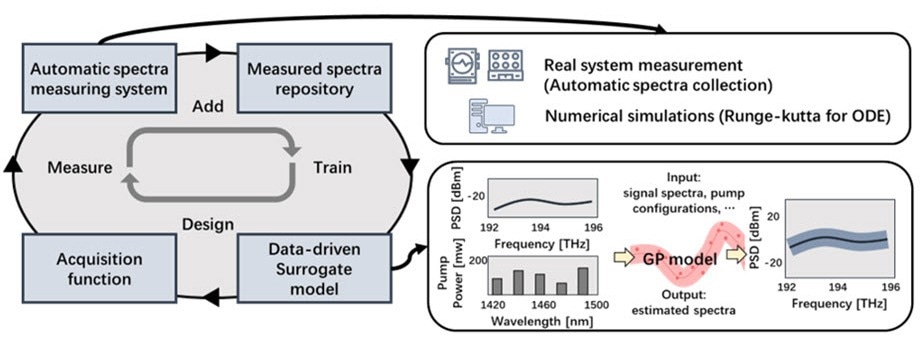According to the study published in Advanced Photonics, researchers from Shanghai Jiao Tong University created a new framework based on Bayesian inference that significantly reduces data needed to model and control optical power evolution, leading to a more cost-effective approach for autonomous optical networks.
 A newly developed Bayesian inference framework (BIF) efficiently models and controls the optical power evolutions in fiber-optic communication systems. Leveraging Bayesian theory, the BIF selects the next-to-be-measured spectrum or optical amplification configuration, using performance estimation and uncertainty analysis. The approach enables simultaneous exploitation and exploration of data space to identify the most suitable candidates, thus reducing the data size needed. Image Credit: Liu, et al.
A newly developed Bayesian inference framework (BIF) efficiently models and controls the optical power evolutions in fiber-optic communication systems. Leveraging Bayesian theory, the BIF selects the next-to-be-measured spectrum or optical amplification configuration, using performance estimation and uncertainty analysis. The approach enables simultaneous exploitation and exploration of data space to identify the most suitable candidates, thus reducing the data size needed. Image Credit: Liu, et al.
The rise of internet services like virtual reality and AI-generated content has increased the demand for bandwidth globally, placing great strain on fiber-optic communication systems.
Since it controls the amount of impairment noise and signal transmission quality, precisely modeling and controlling the optical power evolution (OPE) over fiber links is one of autonomous driving optical networks (ADON's) most crucial responsibilities.
The optical strength of signals in fiber-optic communication systems fluctuates between wavelengths. It evolves along the fiber, posing a challenging physical process, particularly for multiband systems with severe Kerr nonlinearity and interchannel-stimulated Raman scattering.
The key factors influencing OPE in multiband ADONs are the amplification and fiber propagation processes. Specifically, optical amplifiers (OAs) present OPE's biggest modeling and control problem. Approaches based on data can get a high degree of accuracy.
However, to create good digital twin models, standard data-driven techniques, particularly neural networks (NNs), demand a large amount of data, which raises the cost of measurement significantly.
Although certain methods, such as transfer learning or leveraging existing physical knowledge, can reduce the number of measurements needed, data selection has largely been overlooked.
The Bayesian inference framework (BIF) presented by academics from Shanghai Jiao Tong University (SJTU), Shanghai, China, effectively modeled and managed the evolution of optical power in fiber-optic communication systems.
The BIF uses both performance estimation and uncertainty analysis to determine the next spectrum/OA configuration to be measured using Bayesian theory. This method lowers the required data size by allowing for the simultaneous exploitation and exploration of data space to find the best candidates.
The researchers carried out in-depth experiments and simulations in C+L-band fiber-optic transmission systems to simulate and control the OPE with heterogeneous OAs, such as an erbium-doped fiber amplifier (EDFA) and a Raman amplifier (RA).
When utilizing randomly obtained data, the suggested BIF can minimize the data required for modeling by more than 60% with an RA and more than 80% with an EDFA compared to NN-based modeling methods.
Controlling involved iteratively adjusting the pump configurations and signal spectra, which allowed for achieving arbitrary goal gain/power spectra in less than 30 iterations.
This work offers an effective method for choosing data to measure sequentially. To achieve data-efficient modeling and OPE control, the measured data can be used immediately to inform the subsequent cycle of data collection and optimization.
Furthermore, the suggested framework's probabilistic analysis demonstrates promise for network operations reliability analysis, which is crucial for ADON.
The proposed framework can be a promising technical path for realizing data-driven ADON in future optical networks.
Qunbi Zhuge, Professor, and Study Corresponding Author, Shanghai Jiao Tong University
Journal Reference:
Liu, X., et al. (2024) Digital twin modeling and controlling of optical power evolution enabling autonomous-driving optical networks: a Bayesian approach. Advanced Photonics. doi.org/10.1117/1.ap.6.2.026006.